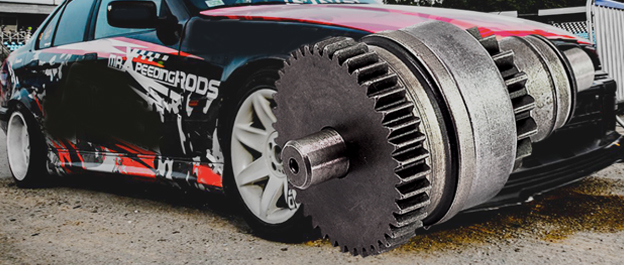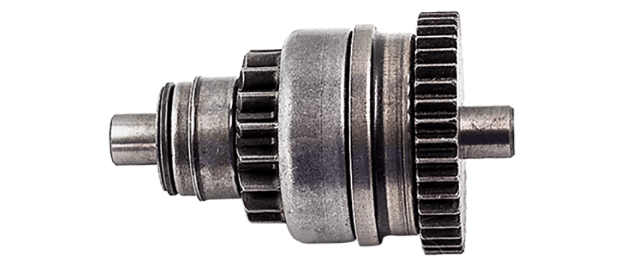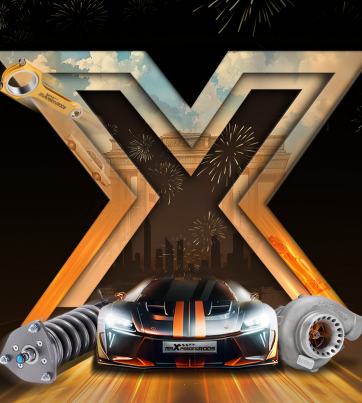Buying a starter motor for your car can sometimes be a daunting and confusing task. At maxpeedingrods.com, it is our mission to make that task as an easy and painless as possible. This Buyer's Guide is designed to answer any questions you may have during your search for the right starter motor for your car, and how to buy starter motor on our website.
What is a starter motor?
A starter motor is an electrical device used to start an internal combustion engine. Typically a very low-geared device, this motor is able to crank over the much larger engine by virtue of its extreme gear reduction. The starter motor is a part of a starting system consisting of the starter, a starter solenoid and the battery. As the ignition switch is turned, it sends an electrical charge to the starter solenoid. This, in turn, sends the charge to the motor that cranks the engine until it starts. Once the engine fires to life, the starter motor clicks off and disengages the starter ring.
How does starter motor work?
The starter motor includes a heavy steel or aluminum case that houses an armature that is wound around by heavy copper wire. The aluminum case has electrical brushes that lie in contact with the armature. When the ignition switch is turned to the start position, the current from the battery flows through the solenoid. This causes the armature to rotate, which in turn pushes or drives a bendix/pinion. This pinion engages the starter gear with the flywheel to turn the crankshaft of the engine.
How to choose a starter motor?
When choosing a motor starter, you should consider the load, the type of motor, and the network before deciding which one is best for you.
Types of Motor Starters
Soft Starters: Soft starters steadily ramp up the speed of a motor to prevent large current surges
and to minimize the amount of wear on electrical contacts in the system. Soft starters are typically
used with on/off devices such as compressors or conveyer belts.
Variable frequency drives: A variable frequency drive (VFD) can control the speed of the motor
during the start and stop cycle and throughout the run cycle. A VFD is optimal for applications that
require complete speed control.
If for any reason you cannot find your starter by entering your vehicle's year, make and model, you can find it by its Original Equipment Manufacturer (OEM) number. The OEM part number can be found directly on the part itself. You can also call a dealership with your VIN, and they will provide you with the OEM part number.
Why buy starter motors at MaXpeedingRods?
MaXpeedingRods has been engaged in the research of overseas racing products and culture for
decades. If you are looking for starter motors, you have landed at the right place. On the basis
of your vehicle make and model, you can choose from a plethora of automotive maintenance and
accessories. MaXpeedingRods offers a seamless online shopping experience and the streamlined
e-commerce interface makes it easy for you to find just the starter motor you want.
MaXpeedingRods offers a variety of starter motors with high quality.
• Direct Replacement for your Starter Motor.
• Quality: ROHS; ISO/TS16949; ISO9001:2008
• Fitment Tested
• op quality Aftermarket part.

What are the symptoms of a defective starter motor?
A failing starter will obviously be slow to crank. However, there are other symptoms of a faulty starter:
1. Car won't StartA starter that has failed completely will not allow the vehicle to start. When the ignition key is turned on, the dashboard lights will come on but the vehicle will fail to start.
2. Unusual Sounds
If you hear a clicking noise from under the hood of the automobile, when the ignition key is turned
on, it can be a symptom of a bad starter.
If the engine starts turning and if you hear multiple clicks until the key is released, then the
starter is properly functioning; and the issue lies with some other component.
A grinding noise, sometimes accompanied by a whirring noise, indicates problems in the starter gear
engagement with the flywheel.
Headlights that function properly when the engine is turned off, but go dim after the ignition key is turned on is a symptom of a malfunctioning starter. This is because the starter draws more voltage from the battery, lowering the voltage that is sent to the headlights.
4. Smoke from under the HoodA burn out starter motor will emit smoke from under the hood of the car.

How to install a starter motor in a car?
Knowing how to change a starter motor will help you stretch your car maintenance budget, so you can use that money for other maintenance tasks. Using the correct steps, you'll avoid ending up with an electrical short circuit, damage to the new starter motor or some other components, and, most importantly, you'll pay attention to key procedures that may apply to your particular vehicle model. But don't worry, you don't need to have much experience working on cars. And, on most vehicle models, you can replace a failed starter at home using some common tools you might already have in your toolbox.
Tools You'll Need:
• Wrench set
• Floor jack, 2 jack sands, 2 wooden blocks
• Goggles
• Ratchet, extensions and socket set
• Wire brush
• Shop rags
• Degreaser, if necessary
• Torque wrench
In most cases, replacing a starter motor requires a few common tools you might already have in your
toolbox. However, before you start, locate the starter in your particular vehicle model.
Some starter motors sit towards the lower or upper section and to one side of the engine, next to
the transmission — on the radiator side. If you can't reach the motor from above, you'll need to
lift the front of the car, secure it safely on jack stands, choke the wheels and work on it from
under the vehicle.
Other models may locate the starter between the firewall and the engine, in the lower section.
It makes for a little more difficult but not impossible repair job. Still, other models have the
starter on top of the engine, in a valley section under the intake. Under this configuration, you
need to remove the intake plenum and other components just to gain access to the unit.
On a few models, you may need to remove key components, like a motor mount, to gain access to one or
more mounting bolts.
Although you may remove some of these components without much problem, you may have to use a
particular procedure, like properly supporting the engine.
If you think you need to remove one or more components you don't feel sure how to deal with, consult
the service or repair manual for your particular vehicle make and model. You can buy an inexpensive
aftermarket repair manual at most auto parts stores or online. So make sure you have all the tools
necessary for the job before you start.
Step 1: Park your car on a level surface and disconnect the negative or black battery cable using a
wrench.
Step 2: Isolate the disconnected cable terminal from the battery to prevent it from accidentally
touching the battery post as you work on the starter. You may want to wrap a shop rag around the
terminal.
Step 3: If you can't reach all the starter mounting bolts from above, raise the front of your
vehicle with a floor jack and set it safely on jack stands.
Step 4: Then, use a couple of wooden blocks to block the rear wheels and engage the emergency
brakes.
Step 5: Put on your goggles and crawl under the car.
Step 6: Locate the battery cable and any other wires attached to the rear of your starter motor — or
solenoid on top of the starter — and disconnect them using a wrench. Make a note of the location of
each wire so that you can replace them correctly, if necessary.
Step 7: Remove any brackets and shields from the starter.
Step 8: Then, loosen the two or three starter mounting bolts using your wrench and ratchet
tools.
Step 9: Check for any shims installed between the motor and engine block. Does your starter motor
use one or more shims? Make a note of their position and location. If you don't reinstall these
shims in their original position and location, the pinion gear on your starter motor and flywheel
gear on the engine will not mesh correctly, and either component may suffer some damage.
Step 10: When ready, hold the starter motor with one hand, finish removing the starter motor
mounting bolts and remove the starter from the vehicle.
Take the old starter to the auto parts store and compare the old unit to the new one, and make sure
it has the same configuration. However, some newer replacement starters are smaller but more
efficient than the old models. Still, most likely you'll need to exchange the old starter for the
new one. And remember to always handle the new starter with care to prevent damage to internal
components.
To install the new starter:
Step 1: Thoroughly clean the starter mounting area on the engine and transmission bell housing. Use
a wire brush, shop rags and degreaser, if necessary.
Step 2: Hold the new unit in place with one hand and place the spacer shims, if any, between the
starter motor and the engine block; replace any mounting
bracket as well. Start the mounting bolts by hand to prevent cross threading the bolts.
Step 3: Before you tighten the mounting bolts, connect the battery cable and any other wires to the
rear of the starter motor.
Step 4: Now, tighten the mounting bolts to the manufacturer specifications using a torque wrench.
Look up the bolts torque
specifications on your vehicle repair manual.
Step 5: Install any brackets and shields as necessary. If your starter comes with a heat shield,
make sure to reinstall it.
Without it, the heat from the exhaust manifold can ruin the electrical circuit inside the starter,
and soon,
you'll have to replace the new starter gain.
Step 6: After lowering your vehicle, reconnect the battery cable and start the engine to confirm the
repair.
* If the starter remains silent check all the wiring to the starter motor and the battery. Check for
corroded or loose
connections, including the battery.
* If all you hear is a grinding noise, most likely the starter motor is not properly mounted.
Recheck the mounting bolts
and the position of the starter against the transmission mounting surface. Have you forgotten to
install any shims or
brackets?
Once you know how to change a starter motor, you can perform this repair job in about an hour or so
next time around. Not all vehicle engines, though, come with the same overall configuration. If you
need to remove other components to gain access to the starter motor in your particular vehicle, you
can consult the repair manual for your specific car make and model. Always plan ahead of time before
starting any repair job on your vehicle, even if it seems as simple as replacing a starter motor.







